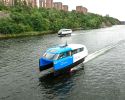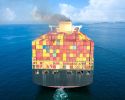Gamification can be useful, but is also risky

Which mode of transport is actually best suited for public transport in Stockholm's inner city? Why not let the game decide? A pre-study carried out within the Swedish Transport Administration's industry program Sustainable Shipping addresses the question of whether gamification can be a way of including waterborne public transport in planning processes for transport infrastructures.
The game plan is a map of Stockholm. You choose a "water bus route", type and size of vessel to operate and departure frequency. You click and quickly find out what health effects and environmental effects your choice of ship has compared to other modes of transport.
“The simulation tool is very simple to understand and easy to click around, which was appreciated by the participants who tested it at workshops we conducted”, says Sebastiaan Meijer, a researcher at KTH who developed the simulation tool.
The idea behind the gamification of the water bus routes is to bring a new way of thinking into the planning processes for public transport. These are generally well-established and follow a series of steps that have been developed over decades, making it difficult to include new modes of transport and perspectives on transportation. And as a door opener, games and simulators definitely have potential.
“Gamification is a well-suited method for handling early planning processes. The participants appreciated the opportunity to be able to work with a quantitative model of reality and not just take part of an end result of a simulation study. The game made the participants engaged, which led to reflective conversations and broad discussions.”
But commitment can also be a problem. The study clearly shows that gamification requires a certain amount of caution - despite the participants being aware of limitations and possible limitations in the data, they tended to quite uncritically see the results' figures and graphs as very credible, almost as true. The risk of drawing hasty conclusions is thus great.
Another problem and challenge is to create a simulation tool with sufficient capacity to be able to provide results that traffic and community planners benefit from. The game dynamics in the prototype handled 450 pre-calculated simulations with overall variables, which is far from sufficient.
“A big problem with simulation tools is that they are very heavy and require a lot of computer power to create. In this version, it was difficult to see any major differences between the different scenarios. Different water buses gave quite similar results. A future useful simulation tool needs to be more scalable and have a modeling freedom where users can draw their own routes, in their particular municipality, on a map, and get the results immediately. There is also a need for far more parameters and, for example, short-term and long-term changes in travel behavior need to be simulated”, says Sebastiaan Meijer.
-
 NextWave – en podd som ska locka unga
NextWave – en podd som ska locka unga -
 Ny studie: Eldrivna pendelbåtar kan effektivisera Stockholms kollektivtrafik
Ny studie: Eldrivna pendelbåtar kan effektivisera Stockholms kollektivtrafik -
 Sjöfartens utsläpp ökar
Sjöfartens utsläpp ökar -
 Sociala relationer påverkar val av bränsle
Sociala relationer påverkar val av bränsle -
 Sjöfartens omställning kräver ”mjukare” påtryckningar
Sjöfartens omställning kräver ”mjukare” påtryckningar -
 Hon hade avtalad tid med Kapten ynkrygg
Hon hade avtalad tid med Kapten ynkrygg -
 Lighthouse omvärldsanalys 2025 – osäkerhet och tullar präglar sjöfarten
Lighthouse omvärldsanalys 2025 – osäkerhet och tullar präglar sjöfarten -
 Se seminariet Shipping in the Marine Environment
Se seminariet Shipping in the Marine Environment -
 Vad betyder egentligen de 90 procenten?
Vad betyder egentligen de 90 procenten? -
 Hålla där...
Hålla där...

